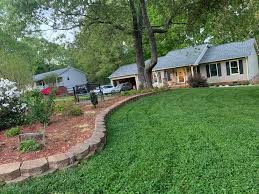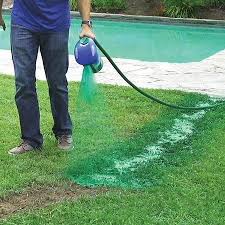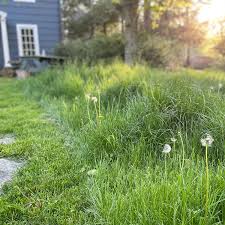A natural lawn is a beautiful area covered with lush, green grass that grows without the use of artificial chemicals or synthetic substances. It’s like a cozy carpet made by nature, perfect for picnics, playing games, or simply relaxing. Creating and maintaining a natural lawn requires some care and attention, but the rewards are worth it.
To start a natural lawn, choose the right type of grass that suits your climate and soil. Grasses like Kentucky bluegrass, fescue, and ryegrass are common choices. Prepare the soil by loosening it up and removing rocks or debris. Adding a thin layer of compost can give the grass a good foundation to grow.
Seeds are like magic for your lawn. Spread the grass seeds evenly over the soil, either by hand or using a spreader. Pat the seeds gently into the soil with a rake or your feet. Watering is important for seeds to sprout, so keep the soil consistently moist until the grass is about 2 inches tall.
As the grass grows, mowing becomes your new chore. Use a sharp mower blade and cut only about a third of the grass height each time. This helps the grass stay strong and healthy. Leaving the grass clippings on the lawn acts as a natural fertilizer, giving back nutrients to the soil.
Weeds are like unwanted guests in your lawn party. To keep them at bay, you can pull them out by hand or use natural weed control methods. Some folks even plant clover along with the grass. Clover not only adds a touch of green but also helps to prevent weeds.
Nature has its own way of feeding your lawn. Fertilizers made from natural ingredients like compost, bone meal, or seaweed can be sprinkled on the grass to give it a boost. Remember, a little goes a long way – you don’t want to overfeed your lawn.
A natural lawn is a haven for many tiny creatures like earthworms and beneficial insects. These little helpers aerate the soil and keep harmful pests away. Using chemical pesticides can harm them, so it’s better to embrace these tiny workers.
Watering your lawn is like giving it a drink. Water deeply but less frequently to encourage the grass roots to grow deeper into the soil. Early morning is the best time to water, as it reduces evaporation and allows the grass to absorb the water.
Over time, your natural lawn will flourish into a soft, vibrant carpet of green. It will be a place where you can connect with nature, enjoy the fresh air, and find solace in its simplicity. Remember, a natural lawn might not be as “perfect” as a chemically treated one, but its imperfections are what make it truly beautiful – just like nature intended.
Read Also: Soybean Pods: Economic Importance, Uses and By-Products
Eco Lawn

An eco lawn is a type of yard that’s designed with nature in mind. It’s a space where sustainability and environmental harmony take center stage. Creating an eco-friendly lawn involves making choices that benefit both your surroundings and the planet as a whole.
One of the key principles of an eco lawn is water conservation. Instead of relying heavily on water, which can be wasteful, consider using drought-resistant grasses. These types of grasses have adapted to require less water, reducing the need for constant irrigation.
Another aspect of an eco lawn is minimizing or eliminating chemical use. This means saying goodbye to synthetic fertilizers and pesticides. Instead, opt for natural alternatives like compost and organic fertilizers. This not only keeps harmful chemicals out of the environment but also nurtures the soil and promotes a healthier ecosystem.
Biodiversity plays a crucial role in an eco lawn. Rather than having a single monoculture of grass, consider planting a variety of plants that support local wildlife. Native plants are especially beneficial, as they provide food and habitat for insects, birds, and other creatures. This creates a balanced ecosystem and contributes to the overall health of your lawn.
Mowing habits can also make a difference. Instead of mowing your lawn too short, let the grass grow a bit taller. Taller grass shades the soil, reducing evaporation and helping to retain moisture. It also promotes stronger root growth, making your lawn more resilient to environmental stressors.
To further reduce your eco lawn’s carbon footprint, consider using manual or electric mowers instead of gas-powered ones. Gas mowers emit pollutants and contribute to air pollution. Electric mowers are quieter, produce no emissions at the point of use, and can be powered by renewable energy sources.
Rainwater harvesting is an ingenious practice in eco lawn care. Collecting rainwater in barrels and using it for irrigation can save a significant amount of water. Plus, rainwater is naturally free from the chemicals found in tap water, which can benefit both your lawn and the environment.
Lastly, an eco lawn is about embracing a more relaxed attitude toward perfection. It’s okay if your lawn has a few “weeds” or if it’s not as manicured as a traditional lawn. These imperfections are part of the natural charm of an eco-friendly space.
In a world where environmental concerns are becoming more pressing, cultivating an eco lawn is a small but impactful way to make a positive change. By nurturing the land, conserving water, and supporting biodiversity, you’re not just creating a beautiful outdoor space – you’re also contributing to a healthier planet for generations to come.
Liquid lawn

Liquid lawn solutions have emerged as a convenient and efficient way to achieve a vibrant and healthy lawn. Unlike traditional methods that involve spreading granular fertilizers and seeds, liquid lawn products come in liquid form and are applied using sprayers. This innovative approach offers several benefits for homeowners seeking a lush and well-maintained landscape.
Liquid lawn fertilizers often contain a balanced blend of nutrients that are readily available to plants. When applied as a liquid, these nutrients are quickly absorbed by the grass, promoting rapid growth and greening. This can be especially beneficial for lawns that need a quick boost, such as after a period of stress or winter dormancy.
The even distribution of nutrients is a notable advantage of liquid lawn care. With granular fertilizers, there’s a risk of uneven application, resulting in patches of over-fertilization or under-fertilization. Liquid fertilizers eliminate this concern, as they can be sprayed uniformly across the lawn, ensuring consistent coverage and results.
Liquid lawn products are also known for their ease of application. Using a sprayer, homeowners can cover large areas quickly and efficiently. This is particularly advantageous for those with expansive lawns, as it saves time and effort compared to manually spreading granular products. Additionally, liquid solutions can be mixed and applied in a single step, reducing the need for multiple applications.
Another perk of liquid lawn care is its versatility. In addition to fertilizers, liquid solutions can include seed starters, weed control treatments, and even beneficial microbes. This all-in-one approach simplifies lawn maintenance by addressing various needs in a single application.
However, it’s important to note that while liquid lawn care offers numerous benefits, it may require more frequent applications compared to slow-release granular fertilizers. Because liquid nutrients are quickly absorbed, they may need to be reapplied to sustain the lawn’s health and appearance over time.
As with any lawn care approach, proper timing and correct application techniques are crucial for achieving the best results. Reading and following the manufacturer’s instructions is essential to avoid over-application or other issues.
In addition, liquid lawn care has revolutionized the way homeowners maintain their lawns. With its quick absorption, even distribution, and convenience, it offers an effective alternative to traditional granular products. By embracing liquid lawn solutions, you can enjoy a vibrant, well-nourished lawn that adds beauty and value to your outdoor space.
Importance of well Maintained Lawn

Here are three important benefits of a healthy and well-maintained lawn:
1. Enhanced Aesthetics: A lush, green lawn adds beauty and curb appeal to your property. It creates a welcoming and visually pleasing environment that can increase your home’s value. A well-groomed lawn serves as a backdrop for outdoor activities, gatherings, and relaxation, making your outdoor space more enjoyable for you, your family, and guests.
2. Environmental Benefits: Healthy lawns offer numerous environmental advantages. They help to reduce soil erosion by stabilizing the soil with their root systems. Grass also acts as a natural filter, trapping dust and pollutants, and producing oxygen through photosynthesis. Moreover, a dense lawn helps to absorb rainwater, reducing runoff and the risk of flooding.
3. Community and Mental Well-being: Lawns provide communal spaces where neighbors can gather, children can play, and people can engage in outdoor activities. These areas promote social interaction and community bonding. Additionally, being around green spaces has been shown to have positive effects on mental health, reducing stress and promoting relaxation and well-being.
Incorporating these aspects into your lawn care routine can lead to a more vibrant and meaningful outdoor living experience.
Read Also: A Guide to Growing and Caring for Floratam Grass (Stenotaphrum Secundatum)
Sod Cost Per Square Foot
The cost of sod per square foot can vary widely depending on factors such as the type of grass, the region you’re in, and any additional services or considerations. On average, sod can range from $0.30 to $0.80 per square foot.
Keep in mind that these figures are approximate and can change based on your specific location and the specific type of grass you’re interested in. It’s a good idea to get quotes from local suppliers or landscaping companies to get a more accurate estimate for your project.
Read Also: The Different Classification of Products





